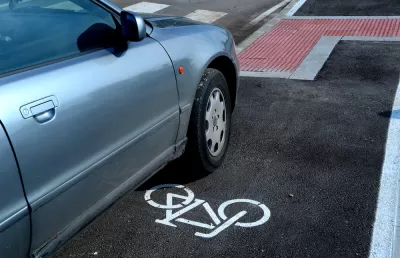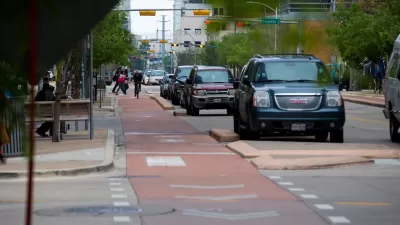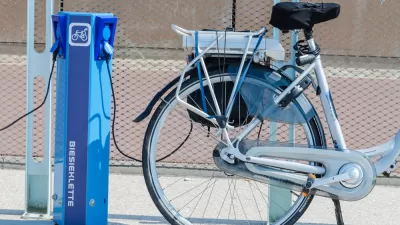To some, a protected bike lane saves lives; to others, it threatens the survival of a community.

The District Department of Transportation (DDOT) is considering several options for a new protected bike lane in downtown Washington. Three of the four proposed options run along Shaw-neighborhood stretches of 6th St/Route 50, a busy commuter street running from Capitol Hill north into the suburbs. According to the Washington Area Bicycle Association, 12 cyclists were hit last year on this stretch of 6th St NW.
At least one of the proposed options is adjacent to the United House of Prayer for All People (UHOP), a century-old church with a strong historical presence in the neighborhood. Congregants are vociferously opposed to a protected bike lane because it would reduce the number of parking spaces available to its congregants, who currently enjoy special Sunday street parking privileges. Many congregants showed up to a DDOT meeting at the Shaw library to voice their opposition, highlighting what Perry Stein characterizes as "a tension in the rapidly changing District between longtime, black residents and new, largely white residents."
"This ain’t London, this ain’t Europe. The United States is built on the automobile and we need to respect that," said Michael Green, a deacon at New Bethel Baptist Church, another church in the neighborhood that would be affected by one of the four bike lane options.
Shaw and surrounding neighborhoods have experienced rapid demographic change over the past 15 years. While gentrification is difficult to define, many cite the NW neighborhoods near Capitol Hill as prime examples of it. Median home values and household incomes in much of the area have nearly doubled. The majority-Black church perceives the bike lanes as another city policy driving out African-Americans, according to a letter written to the DDOT by the church's lawyer.
"These conflicts stem from the change in D.C.’s neighborhoods," writes Stein. "Many of D.C.’s churches were built at a time when their neighborhoods, such as Shaw, weren’t as teeming with condos and restaurants, and parking wasn’t as big of an issue. Additionally, many longtime churchgoers have left the city for the suburbs and now commute to their old churches by car."
John Stanton illustrates the positive role the UHOP has played through decades of crime and poverty, with its soul food kitchen and annual Memorial Day parade. "[The parade] has been a central part of Memorial Day for the Shaw and Logan Circle neighborhoods, even during the decades when the area was ravaged by crime and drugs. In fact, for many years UHOP’s parade was one of the few times neighbors would congregate without the flashing red and blue glare of police lights."
The UHOP's lawyer argues that because the protected bike lane would reduce the number of available parking spaces for congregants, it infringes upon "its constitutionally protected rights of religious freedom and equal protection of the laws." The WABA argues that protecting space for cyclists does not prevent anyone from going to church. For its part, the DDOT states that it a non-political agency charged with improving traffic safety and energy-efficient alternatives to single-occupant vehicles.
FULL STORY: Can some big D.C. churches fight off a bike lane? They are bringing large crowds to try.

Planetizen Federal Action Tracker
A weekly monitor of how Trump’s orders and actions are impacting planners and planning in America.

San Francisco's School District Spent $105M To Build Affordable Housing for Teachers — And That's Just the Beginning
SFUSD joins a growing list of school districts using their land holdings to address housing affordability challenges faced by their own employees.

The Tiny, Adorable $7,000 Car Turning Japan Onto EVs
The single seat Mibot charges from a regular plug as quickly as an iPad, and is about half the price of an average EV.

Seattle's Plan for Adopting Driverless Cars
Equity, safety, accessibility and affordability are front of mind as the city prepares for robotaxis and other autonomous vehicles.

As Trump Phases Out FEMA, Is It Time to Flee the Floodplains?
With less federal funding available for disaster relief efforts, the need to relocate at-risk communities is more urgent than ever.

With Protected Lanes, 460% More People Commute by Bike
For those needing more ammo, more data proving what we already knew is here.
Urban Design for Planners 1: Software Tools
This six-course series explores essential urban design concepts using open source software and equips planners with the tools they need to participate fully in the urban design process.
Planning for Universal Design
Learn the tools for implementing Universal Design in planning regulations.
Smith Gee Studio
City of Charlotte
City of Camden Redevelopment Agency
City of Astoria
Transportation Research & Education Center (TREC) at Portland State University
US High Speed Rail Association
City of Camden Redevelopment Agency
Municipality of Princeton (NJ)





























